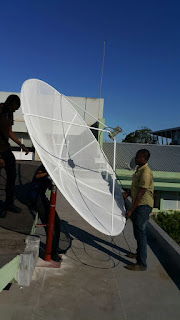SACast will set up a EUMETCast
receiving station (Rx) at the University
of Limpopo, located in Sovenga, South Africa. The project concept was
already tested at the “Greater Zimbabwe University” (GZU) in Masvingo, Zimbabwe
and the “Universidad de Eduardo Mondlane” (UEM) in Maputo, Mozambique.
Alignment of HESCF EUMETCast
Receiving Station at GZU and Indoor Sub-system.
Installation of HESCF EUMETCast
Receiving Station at UEM and Indoor Sub-system.
The funds to procure and setup a Rx
are provided by HESCF.
Of course, donating a Rx is one
thing, making sure that the Rx remains operational for the next 10+ years is
another issue. Not any development/support project should be deployed without a
proper maintenance/support plan towards the future. Therefore, the HESCF-project
liaises with the “Regional Implementation Center” (RIC) of the “Monitoring of
the Environment and Security in Africa” (MESA) project, being the Southern
African Development Community (SADC) – Climate Services Centre (CSC) based at
the Botswana Department of Meteorological Services (BDMS) in Gaborone,
Botswana. They have received the mandate (and the money) from the EU/AUC to
develop and operate a number of EO based services in the SADC countries
(SADC-THEMA) and to setup a network of EUMETCast stations within the relevant
Ministries. They support, maintain and “animate” a network of EUMETCast-users
in Southern Africa, and would be willing to fully incorporate the university in
their Regional and National networks. A “Memorandum of Understanding” should be
signed between UL, HESCF and the MESA/SADC-THEMA, explaining the roles of
each other.
A EUMETCast Receiving Station consists
of:
1.
one powerful multi-core computer, able to run GIS and RS
applications on top of the reception software (24/24 and 7/7);
2.
one flat-screen;
3.
a 2,4m antenna dish (can be a mesh antenna);
4.
a LNB and some coax cable to connect the antenna to the
computers;
5.
a Uninterruptable Power Supply (UPS) to survive (short)
power cuts;
6.
10 TB of external data disks (to store received data);
7.
An EKU (EUMETCast Key Unit) and the TelliCast S/W to
decode and decrypt the DVB signal;
8.
Some free GIS and RS applications (David Taylor package,
AFIS, ILWIS, QGIS, etc).
There are several actors in this
project, i.e. HESCF, the MESA-RIC and the UL. The final beneficiaries are the students from the UL, which
follow GIS or RS related courses.
HESCF will:
·
Fund the procurement costs of EUMETCast Receiving Station;
·
Provide the HESCF stickers to be attached to the antenna.
The MESA-SADC
THEMA RIC will:
·
Support the university to identify a proper location of
the antenna (with a free view to the Atlantic Bird 5 satellite, which
disseminates the EUMETCast signals);
·
Organise the procurement process of the Rx station;
·
Organise the mission of the SADC-CSC personnel to install
the Rx station (the salaries of the staff are being paid by the MESA project);
·
Support the proper functioning of the Rx during the MESA
project and add them to the list of beneficiaries for support in the follow-on
projects;
·
Fully integrate the University in its Regional and
National user network;
·
Invite the University to Regional and National training
events;
·
Share all available training material with the university;
·
Support the students of the university to use the data and
the MESA services;
·
Encourage the university to:
·
use the data for educational and research purposes;
·
fully incorporate EUMETCast data in the courses and adapt
the curriculum;
·
participate actively (as trainers) in National training
events.
The University
of Limpopo will:
·
Prepare and construct a pole on a concrete slab on an
appropriate location at the campus;
·
Provide appropriate security for the antenna equipment
(fence);
·
Provide a proper room for installation of the computers
(in the neighborhood of the GIS lab);
·
Provide support during the installation;
·
Organize the inauguration, and mobilize chancellors,
dean’s, professors and students;
·
Promote the use of the station internally and publish a
news-story on their website;
·
Use the data from station intensively to improve the
quality of the education;
·
Mention the kind contribution of HESCF and SADC-CSC on all
output based on data from the Rx station (e.g. papers, PhD-studies, courses);
· Report yearly some “usage
indicators” of the Rx station during the next 5 years. A relevant usage
indicator could be (I) the number of students being trained with the data and
(ii) the number of PhD students using the data.




Geen opmerkingen:
Een reactie posten